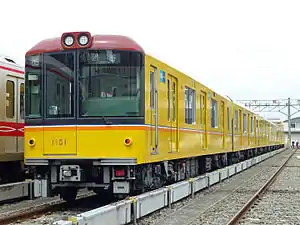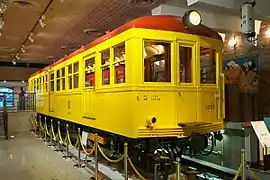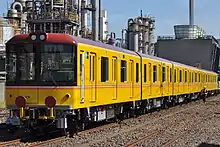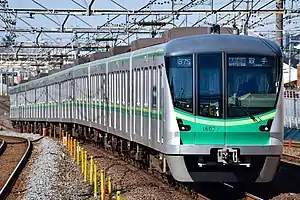Tokyo Metro 1000 series
The Tokyo Metro 1000 series (東京メトロ1000系, Tōkyō Metoro 1000-kei) is an electric multiple unit (EMU) train type operated by the Tokyo subway operator Tokyo Metro in Japan on the Tokyo Metro Ginza Line since April 2012.
| Tokyo Metro 1000 series | |
|---|---|
 Set 1101 in April 2013 | |
| Manufacturer | Nippon Sharyo |
| Built at | Toyokawa |
| Replaced | Tokyo Metro 01 series |
| Constructed | 2011–2017 |
| Entered service | 11 April 2012 |
| Number built | 240 vehicles (40 sets) |
| Number in service | 240 vehicles (40 sets) |
| Formation | 6 cars per trainset |
| Fleet numbers | 1101–1140 |
| Capacity | 93 (28 seating) (end cars), 106 (40 seating) (intermediate cars) |
| Operator(s) | Tokyo Metro |
| Depot(s) | Ueno |
| Line(s) served | G Tokyo Metro Ginza Line |
| Specifications | |
| Car body construction | Aluminium alloy, double-skin |
| Car length | 16,000 mm (52 ft 6 in) |
| Width | 2,550 mm (8 ft 4 in) |
| Height | 3,465 mm (11 ft 4.4 in) |
| Doors | Sliding doors (3 pairs per side) |
| Maximum speed | 80 km/h (50 mph) |
| Weight | 164.5 t |
| Traction system | Toshiba-made VVVF[1] (1st~2nd batch : Si-IGBT device) (3rd batch : silicon carbide hybrid device Si-IGBT SiC-SBD) |
| Traction motors | Toshiba-made permanent magnet synchronous motor[1] |
| Power output | 1,200 kW |
| Transmission | Westinghouse-Natal Drive; Gear ratio: 7.79 : 1 |
| Acceleration | 3.3 km/h/s |
| Deceleration | 4.0 km/h/s (service), 4.5 km/h/s (emergency) |
| Electric system(s) | 600 V DC |
| Current collection method | 3rd rail |
| Bogies | SC101 |
| Braking system(s) | Electronically controlled pneumatic brakes with regenerative braking |
| Safety system(s) | ATC, TASC |
| Coupling system | Tomlinson |
| Track gauge | 1,435 mm (4 ft 8 1⁄2 in) |
The first trainset was delivered in September 2011 ahead of entry into revenue service from 11 April 2012, with full-production sets entering service from 2013.[2]
Design
The design of the new 1000 series trains is a modern rendition of the original 1000 series trains, which were originally used on the Ginza Line when the line opened in 1927. The new 1000 series uses newly developed bogies with steerable axles to reduce flange noise on sharp curves.[3]
Toshiba PMSM (permanent magnet synchronous motors) are used, offering 20% energy savings compared to the VVVF inverter controlled motors used in earlier 01 series trains.[2][1]
The trains are lit entirely with LED lights, including the headlights, offering energy savings of 40% when compared to fluorescent lighting. The LED lighting is supplied by Panasonic Electric Works.[4]
The design was awarded the 2013 Blue Ribbon Award, presented annually by the Japan Railfan Club, and a presentation ceremony was held at Nakano Depot on 12 October 2013.[5]
Formation
The sets are formed as follows, with car 1 at the Shibuya end and car 6 at the Asakusa end.[6]
| Car No. | 1 | 2 | 3 | 4 | 5 | 6 |
|---|---|---|---|---|---|---|
| Designation | CM1 | M1 | M1' | M2 | M1 | CM2 |
| Numbering | 11xx | 12xx | 13xx | 14xx | 15xx | 10xx |
| Capacity Total/seated |
93/28 | 106/40 | 106/40 | 106/40 | 106/40 | 93/28 |
Car 6 in each set was initially numbered in the "16xx" series, but cars were renumbered in the "10xx" series between June and July 2015, and sets 1122 onward were delivered with cars already numbered in the "10xx" series.[7]
Exterior
The trains are finished in a lemon yellow livery applied using vinyl sheets, evoking the appearance of the original 1000 series trains introduced on the line in 1927.[6] Sets 1139 and 1140 were finished to more closely resemble the original 1000 series trains, with a single large front (LED) headlight.[8]
 Original 1000 series car preserved at Tokyo Subway Museum
Original 1000 series car preserved at Tokyo Subway Museum Set 1140, with a single front headlight and different tail lights
Set 1140, with a single front headlight and different tail lights SC101 bogie as used on the 1000 series
SC101 bogie as used on the 1000 series full-colour LED display as used on the 1000 series
full-colour LED display as used on the 1000 series
Interior
Internally, the new trains feature 17-inch LCD passenger information displays above each door.[2] Sets up to 1133 were delivered with two screens, while sets 1134 onwards have three screens, while all prior sets are being retrofitted with the three-screen layout. Seat width is increased from 430 mm to 460 mm. Luggage racks and strap handles have been lowered by 100 mm compared to the 01 series trains.[2]
 General interior view
General interior view Car end section with "Priority" seating
Car end section with "Priority" seating 2-panel LCD passenger information displays in sets up to 1133
2-panel LCD passenger information displays in sets up to 1133 3-panel LCD passenger information displays in sets 1134 onwards
3-panel LCD passenger information displays in sets 1134 onwards 6-person bench seating between doorways
6-person bench seating between doorways 4-person bench seating at car ends
4-person bench seating at car ends 4-person "Priority" seating at car ends
4-person "Priority" seating at car ends car number plate as used on the 1000 series, which also displays the builder, Nippon Sharyo
car number plate as used on the 1000 series, which also displays the builder, Nippon Sharyo driver's cab of the 1000 series
driver's cab of the 1000 series
Sets 1139 and 1140 have retro-style interiors, with brass-coloured handrails and wood-grain effect walls, to closely resemble the original 1000 series trains.[8] The LED lighting in these two sets can be altered to give an old-fashioned tungsten-lighting effect when used on special-event services.[8]
 The interior of set 1139 in May 2017, with special retro-style interior
The interior of set 1139 in May 2017, with special retro-style interior Bench seating inside set 1139 in May 2017, with special retro-style interior
Bench seating inside set 1139 in May 2017, with special retro-style interior Priority seating inside set 1139 in May 2017, with special retro-style interior
Priority seating inside set 1139 in May 2017, with special retro-style interior
History

The first set was delivered from Nippon Sharyo in Toyokawa, Aichi on 17 September 2011.[9] It entered service on the Ginza Line from 11 April 2012.[10] The second set was delivered from Nippon Sharyo in April 2013.[11] The 40th and final set entered service on 12 March 2017.[12]
Fleet details

By 12 March 2017, all 40 sets were in operation.[12] Official delivery dates as follows.[13]
| Set No. | Manufacturer | Date delivered |
|---|---|---|
| 1101 | Nippon Sharyo | September 2011 |
| 1102 | Nippon Sharyo | 30 May 2013 |
| 1103 | Nippon Sharyo | 27 June 2013 |
| 1104 | Nippon Sharyo | 25 July 2013 |
| 1105 | Nippon Sharyo | 22 August 2013 |
| 1106 | Nippon Sharyo | 19 September 2013 |
| 1107 | Nippon Sharyo | 7 November 2013 |
| 1108 | Nippon Sharyo | 28 November 2013 |
| 1109 | Nippon Sharyo | 19 December 2013 |
| 1110 | Nippon Sharyo | 16 January 2014 |
| 1111 | Nippon Sharyo | 27 February 2014 |
| 1112 | Nippon Sharyo | 20 March 2014 |
| 1113 | Nippon Sharyo | 24 April 2014 |
| 1114 | Nippon Sharyo | 22 May 2014 |
| 1115 | Nippon Sharyo | 19 June 2014 |
| 1116 | Nippon Sharyo | 25 July 2014 |
| 1117 | Nippon Sharyo | 21 August 2014 |
| 1118 | Nippon Sharyo | 18 September 2014 |
| 1119 | Nippon Sharyo | 23 October 2014 |
| 1120 | Nippon Sharyo | 20 November 2014 |
| 1121 | Nippon Sharyo | 23 April 2015 |
| 1122 | Nippon Sharyo | 18 June 2015 |
| 1123 | Nippon Sharyo | 23 July 2015 |
| 1124 | Nippon Sharyo | 20 August 2015 |
| 1125 | Nippon Sharyo | 17 September 2015 |
| 1126 | Nippon Sharyo | 22 October 2015 |
| 1127 | Nippon Sharyo | 26 November 2015 |
| 1128 | Nippon Sharyo | 6 January 2016 |
| 1129 | Nippon Sharyo | 31 January 2016 |
| 1130 | Nippon Sharyo | 2 March 2016 |
| 1131 | Nippon Sharyo | 24 March 2016 |
| 1132 | Nippon Sharyo | 2016 |
| 1133 | Nippon Sharyo | 2016 |
| 1134 | Nippon Sharyo | 2016 |
| 1135 | Nippon Sharyo | 2016 |
| 1136 | Nippon Sharyo | 2016 |
| 1137 | Nippon Sharyo | 2016 |
| 1138 | Nippon Sharyo | 2016 |
| 1139 | Nippon Sharyo | 2017* |
| 1140 | Nippon Sharyo | 2017* |
- Classic design
References
- Shikata, K; et al. (16 October 2012). PMSM propulsion system for Tokyo Metro. Electrical Systems for Aircraft, Railway and Ship Propulsion (ESARS). p. 6. doi:10.1109/ESARS.2012.6387456. ISBN 978-1-4673-1372-8.
- 銀座線に新型車両1000系を導入 [New 1000 series trains to be introduced on Ginza Line] (PDF). News release (in Japanese). Tokyo Metro. 17 February 2011. Retrieved 18 February 2011.
- 東京メトロ銀座線に1000系を導入へ [1000 series trains to be introduced on Tokyo Metro Ginza Line]. Japan Railfan Magazine Online (in Japanese). Koyusha Co., Ltd. 18 February 2011. Retrieved 18 February 2011.
- "「鉄道車両用客室内LED照明」を開発" [Railway vehicle interior LED lighting announced]. News Release (in Japanese). Japan: Panasonic Electric Works Co., Ltd. 12 October 2011. Archived from the original on 18 October 2011. Retrieved 24 October 2011.
- 東京地下鉄1000系「ブルーリボン賞」受賞記念式典開催 ["Blue Ribbon Award" presentation ceremony held for Tokyo Metro 1000 series]. Tetsudō Daiya Jōhō Magazine (in Japanese). Vol. 42 no. 356. Japan: Kōtsū Shimbun. December 2013. p. 60.
- "東京地下鉄1000系" [Tokyo Metro 1000 series]. Japan Railfan Magazine. Vol. 51 no. 608. Japan: Koyusha Co., Ltd. December 2011. pp. 60–65.
- 私鉄車両のうごき [Private railway rolling stock changes]. Tetsudo Daiya Joho Magazine (in Japanese). Vol. 45 no. 384. Japan: Kotsu Shimbun. April 2016. p. 127.
- 東京地下鉄1000系特別仕様車 [Tokyo Metro 1000 series special design trainsets]. Japan Railfan Magazine (in Japanese). Vol. 57 no. 671. Japan: Koyusha Co., Ltd. March 2017. p. 66.
- 東京メトロ1000系第1編成が甲種輸送される [First Tokyo Metro 1000 series set delivered]. Japan Railfan Magazine Online (in Japanese). Japan: Koyusha Co., Ltd. 18 September 2011. Retrieved 18 September 2011.
- 東京メトロ銀座線で1000系が営業運転を開始 [1000 series enters service on Tokyo Metro Ginza Line]. Japan Railfan Magazine Online (in Japanese). Japan: Koyusha Co., Ltd. 11 April 2012. Retrieved 15 April 2012.
- 東京メトロ1000系第2編成が甲種輸送される [Second Tokyo Metro 1000 series set delivered]. Japan Railfan Magazine Online (in Japanese). Japan: Koyusha Co., Ltd. 7 April 2013. Archived from the original on 18 August 2016. Retrieved 13 March 2017.
- 銀座線1000系第40編成が営業運転を開始 [40th Ginza Line 1000 series set enters service]. Japan Railfan Magazine Online (in Japanese). Japan: Koyusha Co., Ltd. 13 March 2017. Archived from the original on 13 March 2017. Retrieved 13 March 2017.
- 私鉄車両編成表 2016 [Private Railway Rolling Stock Formations - 2016] (in Japanese). Japan: Kotsu Shimbunsha. 25 July 2016. p. 68. ISBN 978-4-330-70116-5.
External links
| Wikimedia Commons has media related to Tokyo Metro 1000 series. |
- Official website (in Japanese)
- Nippon Sharyo 1000 series information (in Japanese)
